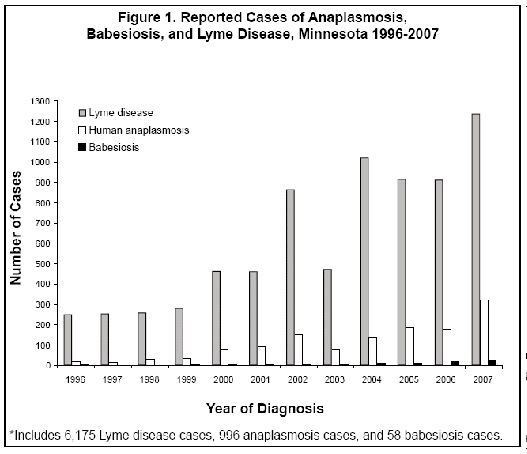Annual Summary of Disease Activity:
Disease Control Newsletter (DCN)
Related Topics
Contact Info
Lyme Disease, 2007
Lyme disease is caused by Borrelia burgdorferi, a spirochete transmitted to humans by bites from Ixodes scapularis (the blacklegged tick or deer tick). The same tick vector also transmits the agents of Anaplasmosis (HA) and babesiosis.
In 2007, 1,239 confirmed Lyme disease cases (23.8 per 100,000 population) were reported (Figure 1). This is a 36% increase from the 913 cases (17.7 per 100,000) in 2006. It is also substantially higher than the 918 cases in 2005 and the previous record number of 1,023 cases in 2004. The frequency of Lyme disease since 2004 has been considerably higher than the median number of cases reported annually from 1996 through 2003 (median, 374 cases; range, 252 to 866). Seven hundred seventy-one (62%) confirmed case-patients in 2007 were male. The median age of case-patients was 41 years (range, <1 to 88 years). Physician-diagnosed erythema migrans was present in 1,019 (82%) cases. Two hundred forty-four (20%) cases had one or more late manifestations of Lyme disease (including 203 with a history of objective joint swelling, 32 with cranial neuritis, four with lymphocytic meningitis, six with radiculoneuropathy, and six with acute onset of 2nd or 3rd degree atrioventricular conduction defects) and confirmation by a positive IgG antibody test or positive PCR. Onsets of illness peaked in July (37% of cases), corresponding to the peak activity of nymphal I. scapularis ticks in mid-May through mid-July.
Lyme disease co-infections with HA and babesiosis can occur from the same tick bite. During 2007, 18 (1%) Lyme disease case-patients also had objective evidence of HA, and four (<1%) had objective evidence of babesiosis. Because of under-detection, these numbers likely underestimate the true frequency of co-infections.
Most case-patients in 2007 either resided in or traveled to endemic counties in north-central, east-central, or southeast Minnesota or western Wisconsin. As in 2006, Crow Wing County continued to have the highest number of Lyme disease case exposures (136 [21%] of 658 cases who reported a single county of exposure in Minnesota). Five hundred fifty-eight (45%) cases occurred among residents of the metropolitan area. However, only a minority of these residents (79 [22%] of 360 case-patients with known exposure) were likely exposed to infected I. scapularis ticks in the metropolitan area, primarily Anoka and Washington Counties. Over half of Lyme disease case-patients in 2007 (482 [60%] of 809 cases with a known activity) were most likely exposed to I. scapularis ticks while on vacation, visiting cabins, hunting, or during outdoor recreation.

- For up to date information see: Lyme disease
- Full issue>> Annual Summary of Communicable Diseases Reported to the Minnesota Department of Health, 2007